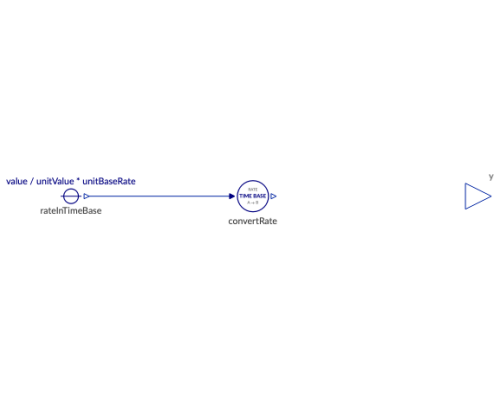ConstantConverterRateA constant rate is turned into a constant-valued signal |
|
Diagram
Information
This information is part of the Business Simulation Library (BSL). Please support this work and ► donate.
The parameter value is used to set the continous output y making it a constant-valued signal. The output will always give rates per second, but rates can be entered in non-SI-units of time using the parameter timeBaseString.
Notes
- In the default setting
ValueTypeis chosen to beTypes.Realsso that the entered rate will be a fractional rate (1 per unit of time). A different choice forValueTypemay give more convenience: SelectingValueType = Amountallows to use `displayUnit = "thousand"` and we can entervalue = 1andtimeBaseString = "year"to come up with a rate of1 thousand per yearnicely converted internally into an equivalent rate per second. - One can further use
ValueTypeto select say a basic physical quantity like energy (not EnergyFlowRate!). Withvalue = 1000,displayUnit = "kW.h", andtimeBaseString = "year"we will thus obtain a rate of1000 kw.H per yearthat is internally converted into SI-units of114.155 J/s. - There is no direct link between
OutputType(default =Rate) andValueType. Thevalueentered will haveunit = ValueType.unit/sand the selectedOutputTypeshould be set to make sure thaty.unitreflects this: In the energy example above, the user should have selectedOutputType = EnergyFlowRateto have units for input and output match.
See also
Parameters (1)
| value |
Value: Type: ValueType Description: Constant rate given in unit and displayUnit pertaining to ValueType per time base |
|---|
Connectors (1)
| y |
Type: RealOutput Description: Constant output signal |
|---|
Components (2)
| rateInTimeBase |
Type: ConstantConverter Description: A constant value is turned into a constant signal |
|
|---|---|---|
| convertRate |
Type: RateConversion Description: Convert the rate input to a rate per seconds |
Used in Examples (2)
|
BusinessSimulation.Examples A first example |
|
|
BusinessSimulation.Examples Human resource planning |
Used in Components (3)
|
BusinessSimulation.Flows.Unidirectional Rate of transition is proportional to the amount in stock A |
|
|
BusinessSimulation.MoleculesOfStructure.InformationProcessing Calculates the present value of a stream of cash flows |
|
|
BusinessSimulation.MoleculesOfStructure.InformationProcessing Calculate the time value of money (TVM) using continuous compounding |
